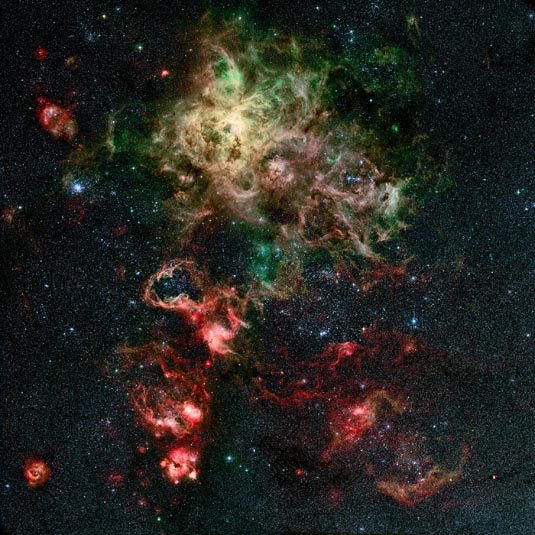
Description: Star formation nebula
Position (J2000): R.A. 05hr 38m 42s Dec. -69° 06.0"
Constellation: Doradus
Distance: 170,000 light years
Field of View: 1.0° by 1.0°
Image Credit: ESO
Release Date: December 21, 2006
More images: N0650 N1023 N0401 N1105 N0121 N0416 N1117 S0932
ABOUT THIS IMAGE:
A
new, stunning image of the cosmic spider, the Tarantula Nebula and its
surroundings, finally pays tribute to this amazing, vast and intricately
sculpted web of stars and gas. The newly released image, made with ESO's
Wide Field Imager on the 2.2-m ESO/MPG Telescope at La Silla, covers 1
square degree on the sky and could therefore contain four times the full
Moon.
Known as the Tarantula Nebula for its spidery appearance, the 30 Doradus
complex is a monstrous stellar factory. It is the largest emission nebula
in the sky, and can be seen far down in the southern sky at a distance
of about 170,000 light-years, in the southern constellation Dorado (The
Swordfish or the Goldfish). It is part of one of the Milky Way's neighbouring
galaxies, the Large Magellanic Cloud.
The Tarantula Nebula is thought to contain more than half a million times
the mass of the Sun in gas and this vast, blazing labyrinth hosts some
of the most massive stars known. The nebula owes its name to the arrangement
of its brightest patches of nebulosity, that somewhat resemble the legs
of a spider. They extend from a central 'body' where a cluster of hot
stars (designated 'R136') illuminates and shapes the nebula. This name,
of the biggest spiders on the Earth, is also very fitting in view of the
gigantic proportions of the celestial nebula - it measures nearly 1,000
light-years across and extends over more than one third of a degree: almost,
but not quite, the size of the full Moon. If it were in our own Galaxy,
at the distance of another stellar nursery, the Orion Nebula (1,500 light-years
away), it would cover one quarter of the sky and even be visible in daylight.
Because astronomers believe that most of the stars in the Universe were
formed in large and hectic nurseries such as the 30 Doradus region, its
study is fundamental. Early this year, astronomers took a new, wide look
at the spider and its web of filaments, using the Wide Field Imager on
the 2.2-m MPG/ESO telescope located at La Silla, Chile, while studying
the dark clouds in the region. Dark clouds are enormous clouds of gas
and dust, with a mass surpassing a million times that of the Sun. They
are very cold, with temperatures about -260 degrees Celsius, and are difficult
to study because of the heavy walls of dust behind which they hide. Their
study is however essential, as it is in their freezing wombs that stars
are born.
Observing in four different bands, the astronomers made a mosaic of the
half-degree field of view of the instrument to obtain an image covering
one square degree. With each individual image containing 64 million pixels,
the resultant mosaic thus contained 4 times as many, or 256 million pixels!
The observations were made in very good image quality, the 'seeing' being
typically below 1 arcsecond.
The image is based on data collected through four filters, including two
narrow-band filters that trace hydrogen (red) and oxygen (green). The
predominance of green in the Tarantula is a result of the younger, hotter
stars in this region of the complex.
It would be easy to get lost in the meanderings of the filamentary structures
or get stuck in the web of the giant arachnid, as is easily experienced
with the zoom-in feature provided on the associated photo page, and it
is therefore difficult to mention all the unique objects to be discovered.
Deserving closer attention perhaps is the area at the right-hand border
of the Tarantula. It contains the remains of a star that exploded and
was seen with the unaided eye in February 1987, i.e. almost 20 years ago.
Supernova SN 1987A, as it is known, is the brightest supernova since the
one observed by the German astronomer Kepler in 1604. The supernova is
known to be surrounded by a ring, which can be distinguished in the image.
A little to the left of SN 1987A, another distinctive feature is apparent:
the Honeycomb Nebula. This characteristic bubble-like structure results
apparently from the interaction of a supernova explosion with an existing
giant shell, which was itself generated by the combined action of strong
winds from young, massive stars and supernova explosions.